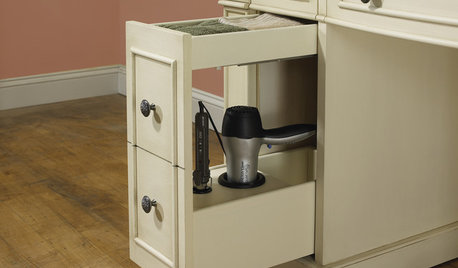Two wire circuit...GFCI
bcrawfo2
13 years ago
Related Stories

CHRISTMASHow to Light Your Christmas Tree Like a Pro
Give yourself frustration-free tree lighting this year — the trick is clever cord management
Full Story
LIGHTINGWhat to Consider When Lighting Your Home
A designer offers a few illuminating insights on this key design element
Full Story
BATHROOM DESIGN10 Amenities to Make Your Bathroom Extraordinary
Go beyond the basics for a luxury bathroom experience, with extra-special options starting at only $25
Full Story
KITCHEN DESIGNDish-Drying Racks That Don’t Hog Counter Space
Cleverly concealed in cabinets or mounted in or above the sink, these racks cut kitchen cleanup time without creating clutter
Full Story
BATHROOM DESIGNHow to Settle on a Shower Bench
We help a Houzz user ask all the right questions for designing a stylish, practical and safe shower bench
Full Story
BATHROOM DESIGNIdea of the Week: Vanity With a Salon Touch
Tired of tossing your hot hair tools underneath your sink? This furniture designer plugs into the perfect solution
Full Story
MIDCENTURY HOMESHouzz Tour: An Eichler Remodel Spawns a Design Career
A homeowner finds her true calling upon redesigning her family's entire California home
Full Story
HOUZZ TOURSHouzz Tour: From Shocker to Stunner in Houston
Once moldy and decrepit, this 1920s bungalow is now a neighborhood gem
Full Story
LIVING ROOMSRoom of the Day: Living Room Update for an 1800s New England House
Major renovation gives owners the open, contemporary feel they love
Full Story
LIGHTINGWhat to Know About Switching to LED Lightbulbs
If you’ve been thinking about changing over to LEDs but aren't sure how to do it and which to buy, this story is for you
Full Story







eekim
Ron Natalie
Related Professionals
Cumberland General Contractors · Highland City General Contractors · Lakewood General Contractors · Modesto General Contractors · Redan General Contractors · Rossmoor General Contractors · Titusville General Contractors · Albany Solar Energy Systems · Carson Solar Energy Systems · Englewood Home Automation & Home Media · Leander Home Automation & Home Media · Odenton Home Automation & Home Media · Richfield Home Automation & Home Media · St. Johns Home Automation & Home Media · Stamford Home Automation & Home Mediabcrawfo2Original Author
brickeyee